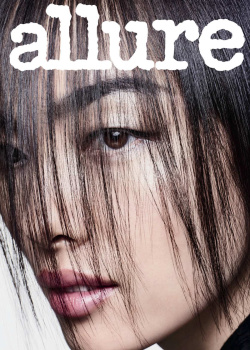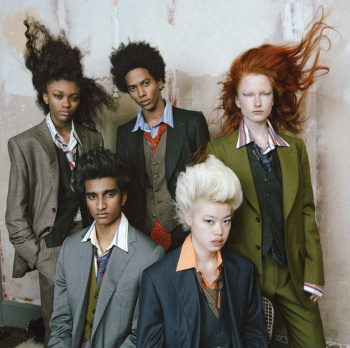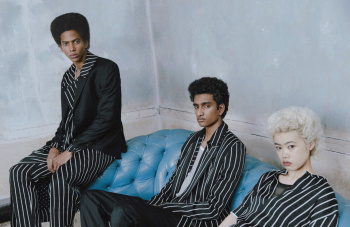You are using an out of date browser. It may not display this or other websites correctly.
You should upgrade or use an alternative browser.
You should upgrade or use an alternative browser.
Allure June 2018 : Fei Fei, Fernanda, & Soo Joo by Solve Sundsbo
- Thread starter serendipity8777
- Start date
djowodjo30
Well-Known Member
- Joined
- Mar 5, 2011
- Messages
- 520
- Reaction score
- 418
Fei Fei's cover looks like those japanese horror movie poster...
YohjiAddict
Well-Known Member
- Joined
- May 26, 2016
- Messages
- 3,657
- Reaction score
- 5,198
Three impactful covers, I feel like the execution in Soo Joo's cover is a bit lacking but I find no fault with the other two.
TaylorBinque
Well-Known Member
- Joined
- Apr 4, 2010
- Messages
- 2,986
- Reaction score
- 1,409
These covers give me life!!! Seriously, all three of them are working it. But Fernanda cover really pops.
zzzyao76
Active Member
- Joined
- Jan 27, 2016
- Messages
- 4,748
- Reaction score
- 90
Photo: Sølve Sundsbø
Hair: Malcolm Edwards
Makeup: Hiromi Ueda
Manicure: Chisato Yamamoto
Stylist: Beat Bolliger



allure
Fei Fei Sun
Fernanda Ly
Soojoo Park
Hair: Malcolm Edwards
Makeup: Hiromi Ueda
Manicure: Chisato Yamamoto
Stylist: Beat Bolliger



allure
Fei Fei Sun
Makeup in the best case carries a little bit of magic with it. The transformative process lets you try on different personas without ever getting more than a cleansing wipe’s distance away from neutral, which is how Sun, homebody and new global face of cosmetic giant Estée Lauder, sees it.
“If I have somewhere to go,” says the model, who has worked with Chanel, Dior, and Prada but prefers a good farmers’-market outing to a red-carpet event, “I moisturize my face and do a bright color on my mouth. It’s simple, but it always gives me confidence.” For the newlywed, who married her longtime boyfriend, Liang Zi, this past winter, the notion of simplicity extends to her hair. “I feel the most beautiful with it long and healthy and its natural color,” says Sun. A tall girl at 5 feet 10 and given to hunching, she was enrolled by her mother in modeling school on the advice of a friend who thought the posture classes might help. Sun fell in love. “There are so many great things that I learned from this industry, like patience” — though given her career successes, that might have been one skill she didn’t need to practice.
Sun, who resides in New York City but still considers Shanghai home, has had the unique experience of being the first Chinese woman to appear on the covers of American, Italian, and Japanese Vogue — and the significance is not lost on her. “China has an old saying: ‘Flowers are beautiful because the seeing is free.’ We need more and more girls from different countries on the runway and in magazines and in global campaigns.”
Fernanda Ly
Ly is used to standing out. Before the Chinese-Australian model crashed the international fashion mainframe in a scene-stealing debut at Louis Vuitton’s 2015 fall runway show, Ly was an architecture student in Sydney. After traversing the hair-color spectrum, she was eventually discovered in a shopping mall with her now-signature cotton candy shade. “Louis Vuitton was the last day of fashion week,” says Ly, “and the next day literally all the fashion-news headlines were like, ‘Who’s that girl with pink hair?’ And instead of going back home to Australia, I went to New York. Hair is work for me now. When you think pink hair, you think of me.”
Ly has since found other mediums through which to express herself. In March 2017, she contributed to a models.com survey about models’ treatment in the fashion industry, including a personal #MeToo account of the time she was groped by a stylist. “It’s nerve-racking to write about these things,” says Ly. “But change happens because someone is willing to put their name down.”
Her advocacy doesn’t stop there. This spring, via a story on identity published in Australian Vogue, Ly expressed how she is still wrestling with how she sees herself. “I’m torn because obviously I’m Asian, but I grew up really Western.” Ly appreciates the influence she holds and the progress that has been made. “Australia has so many Asian people, but when I started out, pretty much every model was white. It’s an alienating experience — you feel so physically different. I appeared at the time when everything started to change; people like Lineisy [Montero] and Ruth Bell started to break the norm. I guess I’m the colored-hair version of that for Asian girls.”
Soojoo Park
At 26, the age that some models might have started side-eyeing their savings accounts, Park’s career took a turn for the stratospheric. Having graduated with a degree in architecture from UC Berkeley, Park had taken a job in graphic design for a Web company when she was scouted in San Francisco. Park arrived in New York City to face a demoralizingly slow burn of casting calls. As in any good movie montage, the catalyst took the form of reinvention — with a sacrifice of the silky, straight, virgin black hair she inherited from her mother.
“Going platinum took, like, eight hours and cost maybe two grand. But I really liked the look. It suited my face quite well.” A meeting with Carine Roitfeld followed, and after her subsequent introduction to Tom Ford and Karl Lagerfeld, Park found herself working at a clip. “I started booking a lot of jobs and built my career on being bleach blonde.”
Park immigrated to Anaheim, California, from Seoul when she was 10, with two parents who didn’t necessarily subscribe to their new home’s cultural outlook as readily as she did. Now the Chanel darling finds herself with an unexpected podium she can use to speak to young women, and she knows what she wants to say. “Asian and Asian-American heritage is really heavily underrepresented in the industry, and I want to push for inclusion. We’re the fastest-growing minority in the country, but you hardly ever see one of us on the cover of a major American publication. I just want to think about who I am and what I represent and how I can help other people who are like me.”
Park knows how lucky she is to enjoy her level of success at the age of 32. “The progress that we’ve made in the last few years is really amazing. Now there are girls in their natural Afros or hijabs, lots of drastic hair colors, really representing the different kinds of beauty out there. With my bleached eyebrows and hair, I’ve had a beauty contract with L’Oréal Paris since 2015, and I’m really grateful that they are embracing a woman of color who isn’t a stereotypical idea of an Asian beauty.” But even now, the rumble to reinvent still reverberates. “I’ll color my hair during the holidays because it’s when I can have fun and experiment. I’ve done it blue, green... I really liked pink. I’ve always wanted to try really bright fire red, but that’s really difficult to go back to blonde after.” That doesn’t sound like it will stop her.
Last edited by a moderator:
Benn98
Well-Known Member
- Joined
- Aug 6, 2014
- Messages
- 42,582
- Reaction score
- 20,774
Odd that Solve appears to be working for both Hearst and CN. Now that Demarchelier is persona non grata, maybe Phyllis Posnick should consider locking him down for her one page stories. The shot of Fernanda looks like it would be right up her street.
theBlueRider
Well-Known Member
- Joined
- Apr 8, 2006
- Messages
- 601
- Reaction score
- 208
Three epic covers! A Chinese model, Australian-Chinese model and American-Korean. This is beauty and diversity done the right way!
FashionMuseDior
Well-Known Member
- Joined
- Feb 27, 2012
- Messages
- 1,785
- Reaction score
- 725
Because this is an all about hair issue duh. Can't you read?GOSH I love these models but the covers are plain f*** UGLY!!! They won´t sell !!! Where in the world have you seen covers that hide the whole face of the model and you see no clothes on a magazine cover supposed to sell Fashion??????? This is RIDICULOUS!
Hair is just as fashionable as clothes, darling.
D
Deleted member 1957
Guest
Stunning covers tho am somethat bothered by SooJoo's ends which look split which i find odd for a beauty and hair mag.
serendipity8777
Well-Known Member
- Joined
- Oct 5, 2009
- Messages
- 1,750
- Reaction score
- 151
Zorka
Well-Known Member
- Joined
- Jan 29, 2014
- Messages
- 18,873
- Reaction score
- 21,581
kokobombon
Well-Known Member
- Joined
- Oct 7, 2007
- Messages
- 18,847
- Reaction score
- 2,392
imo best Allure issue in a while. Even "Back to the Future" with all its indie photography pretentiousness is interesting to me, with all the hair movement.
tigerrouge
Well-Known Member
- Joined
- Feb 25, 2005
- Messages
- 18,945
- Reaction score
- 9,875
I'm starting to read through this online; the 'pink' shot is the actual cover in the version I'm looking at, with the other shots being included over the next few pages. The issue seems to be 106 pages.
Bertrando3
Well-Known Member
- Joined
- Mar 22, 2010
- Messages
- 5,634
- Reaction score
- 2,402
This trio shot is MUCH BETTER as a cover!
tigerrouge
Well-Known Member
- Joined
- Feb 25, 2005
- Messages
- 18,945
- Reaction score
- 9,875
The editor's letter harks back to the Lucy Liu cover, and there are fascinating little features on topics like gender-neutral pricing in hair salons, and people who have great lengths for religious/spiritual reasons, as well as the typical advice on products and techniques. The main editorial is as dull as it always is in the new Allure - and then the issue suddenly ends. It feels like there should be twenty pages more. I was looking forward to seeing and reading more.
This issue contains the seed of great things, but in other ways, it feels like an under-developed product. I don't know why there aren't more shots inside of the cover girls, when it's such a big deal to feature them on the front of an American magazine. And it's taken me a while to move beyond the excitement of seeing them to realise these are eye-catching images, but their hair looks like a mess in most of them.
This issue contains the seed of great things, but in other ways, it feels like an under-developed product. I don't know why there aren't more shots inside of the cover girls, when it's such a big deal to feature them on the front of an American magazine. And it's taken me a while to move beyond the excitement of seeing them to realise these are eye-catching images, but their hair looks like a mess in most of them.
Similar Threads
- Replies
- 0
- Views
- 1K
- Replies
- 47
- Views
- 12K
- Replies
- 24
- Views
- 7K
- Replies
- 143
- Views
- 53K
Users who are viewing this thread
Total: 1 (members: 0, guests: 1)
New Posts
-
-
Vogue Czechoslovakia December 2025 : Daniela Peštová by Bohdan Bohdanov & Alexa Chung by Melanie Rodriguez (16 Viewers)
- Latest: jal718
-
-
-
Jonathan Anderson - Designer, Creative Director of JW Anderson & Christian Dior (14 Viewers)
- Latest: KilltheLook



























